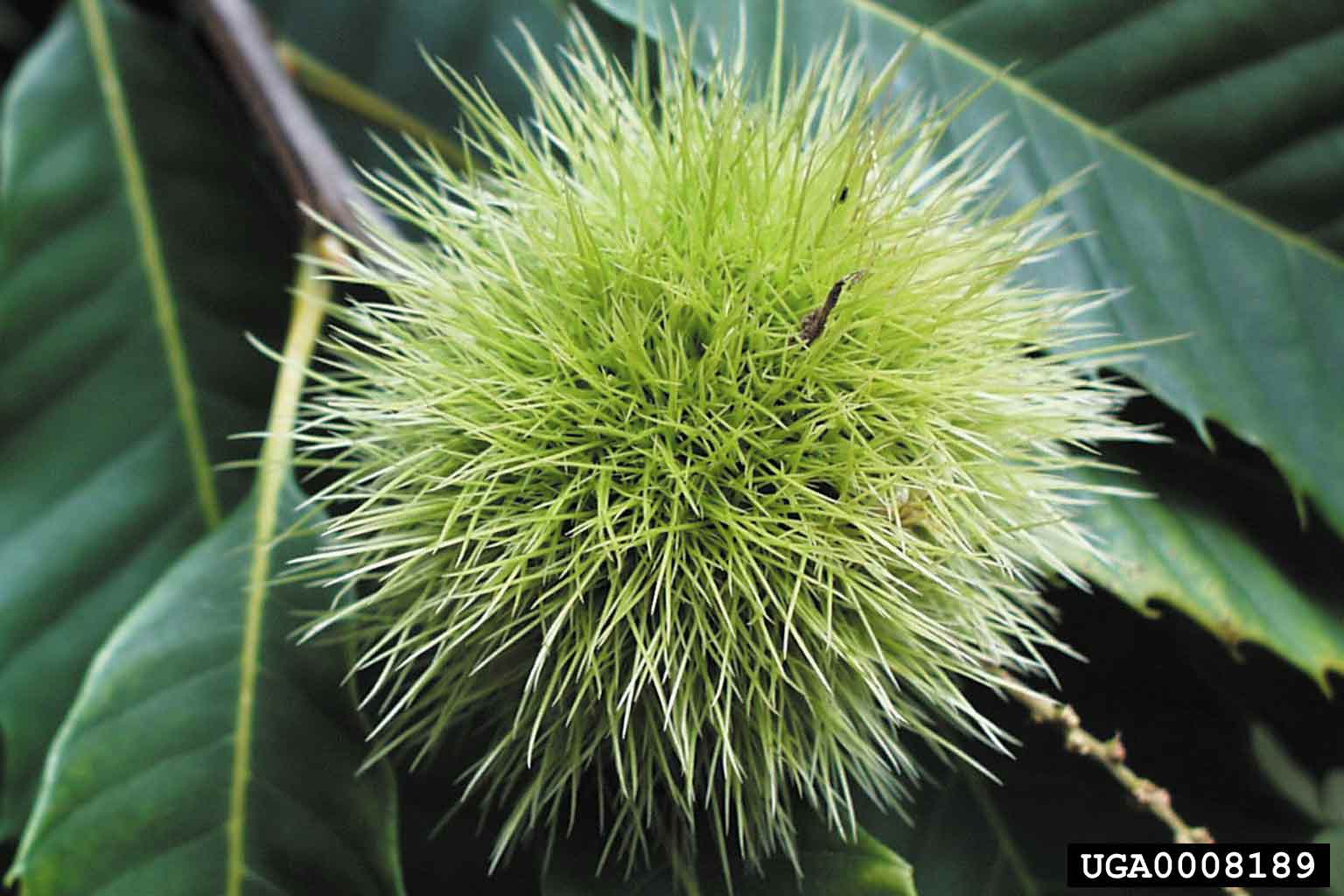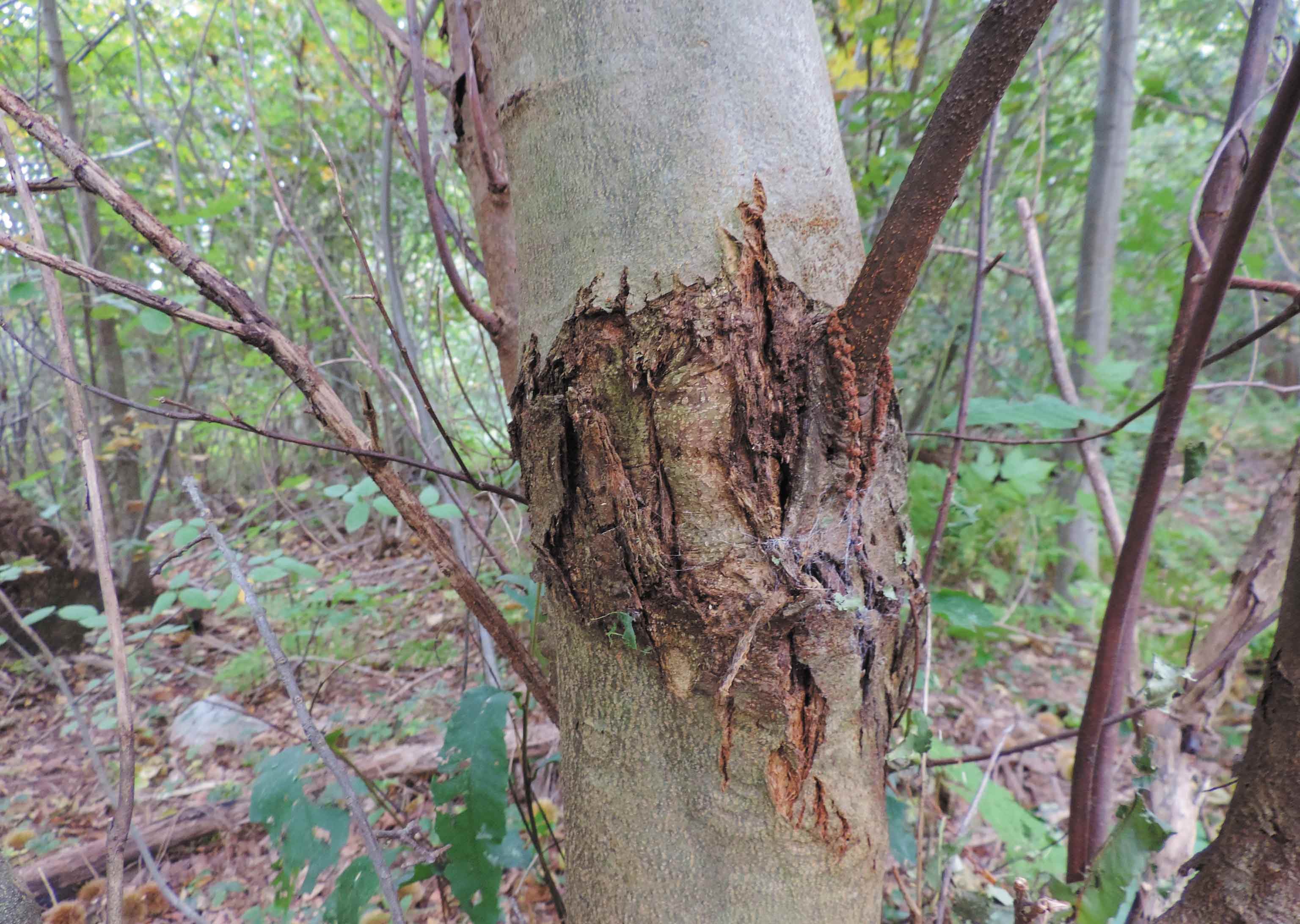A Foe, Insidious and Merciless is Advancing
This article relates warnings of the chestnut blight’s approach on the front page of the Jackson County Journal in Jackson County, NC – how efforts to stop it failed in spite of efforts born of such warnings, and the hopes for the return of healthy chestnut forests. American chestnut fruit (Paul Wray, Iowa State University, Bugwood.org).
American chestnut fruit (Paul Wray, Iowa State University, Bugwood.org).
We can’t say we weren’t warned.
And we can’t say the warnings weren’t heeded.
But in the case of the chestnut blight, warnings, vigilance and the best-laid plans proved to be no match for people in these mountains trying to protect a treasured cultural lodestone and economic engine.
The blight won.
Or at least it won the battle. We’re still fighting the war.
The front page of the Jackson County Journal laid out in stark detail what was heading our way in an article appearing August 24, 1923, headlined, “Real Danger Threatens Our Homeland: An Insidious and Merciless Foe is Approaching,” which reads as follows:
“There is real danger just ahead of us, and only the most careful and patriotic efforts of all our people can save a large part of our region from becoming a barren wilderness, and many of our industrial enterprises from closing down and leaving our people out of employment.
“This sounds like a woeful picture, but it was made so for the purpose of arousing the people of Jackson County, as well as the whole of the chestnut region of Western North Carolina, to the catastrophe that is just ahead of us.
“A few years ago, there were brought to Central Park, in New York City, a few Japanese chestnut trees, which, without the knowledge of the park authorities, were affected with chestnut blight, a tree disease hithero unknown in America. And thus, through carelessness, was brought to this country a foe that threatens us with real and appalling danger. From Central Park the disease spread until it has completely annihilated the chestnut timber throughout New England, and a large part of Pennsylvania, New York, Maryland, and West Virginia, and is gradually encroaching upon North Carolina, having recently made its appearance near Old Fort.
“As the wind blows from South to North in the path of the chestnut blight, it was at first thought that it would not reach North Carolina, but aside from the carrying of the fine dust spores, the disease is spread by birds, and is thus likely to break out in isolated places, as was the case near Old Fort, at most anytime.
“It is thought that he menace can be averted by concerted action of foresters, and people who live in the country, who are warned to be on the look-out for the blight, and immediately take steps to stamp it out, by cutting infected trees and burning them.
“Only by enlisting the aid of the people can this real menace to the happiness of our people, and to the beautiful handiwork of the Creator, be averted. The Champion Fiber Company is leading in organizing the timber and acid wood interests of this region in a fight to combat the disease, and has sent out letters to the Armour Leather Company, at Chicago, Sylva Tanning Company, Sylva, Union Tanning Company, Old Fort, Blackwood Lumber Company, East La Porte, W. M. Hitter and Company, Columbus, Ohio, International Shoe Company, Morgantown, Gennett Lumber Company, Asheville, and other industrial enterprises that are most vitally interested, calling for a meeting to organize the forces to wage the battle.
“It can be seen at a glance the real danger that confronts this region, and in Jackson County, where perhaps is left the greatest acreage of chestnut timber in the world, we are particularly and vitally concerned. With proper lumbering methods, the chestnut timber in this country will be an everlasting source of revenue and beauty, if we can keep the blight from upsetting all calculations that have been made for the future development of Jackson County. This disease is a menace that threatens every activity of our people. Every man and woman in this region is vitally concerned.
“And this paper calls upon all the people to keep on the watch for the blight, report it, and cut the trees that become affected. The next general assembly will be asked to enact legislation allowing an affecting tree to be cut on anybody’s land, anytime, anywhere, and to pass other legislation to assist in the fight. At present, we can
only depend upon the good sense of the people, who,
if aroused to the danger to their homeland, will turn
the trick.”
It did not.
Despite efforts such as felling millions of tress in Pennsylvania and New York to create a firewall, the blight jumped ahead of efforts to contain it and spread at a rate of 50 or more miles a year. Within a generation all that remained of the vast chestnut forests that provided food, forage and highly valued timber were stands of ghostly sentinels.
Chestnut blight does kill the tree, but it doesn’t kill the roots. Trees will send up sprouts that survive until falling again to the blight. Chestnut blight canker (Richard Gardner, UMES, Bugwood.org).
Chestnut blight canker (Richard Gardner, UMES, Bugwood.org).
The American Chestnut Foundation, based in Asheville, has been the tip of the spear in the ongoing war against blight through decades of research dedicated to finding blight-resistant cultivars. Test plots of blight-resistant trees have been planted in the area.
TACF volunteers send in over 2,000 leaf samples annually for testing and identification; volunteers help locate sprouts for entry into a database and help plant trees and monitor test sites. The Foundation also offers seedlings to boost the effort to reestablish his mountain treasure.
The battle to stop the spread of the blight in the 20th century was lost.
But the war is not over.
This article was originally published in the Journal of The American Chestnut Foundation and was reprinted with permission. Jim Buchanan served as editor of the Chashiers Crossroads Chronicle before putting in 29 years at the Asheville Citizen-Times, where he was on the editorial board for 20 years and editorial page editor his last eight. Currently, he is the editor of the Sylva Herald.
